Kate Rauner's Blog, page 75
February 24, 2016
Flowers Saved Forever #amber #flower #fossil #poetry

Fossils in amber
I have petals from my love
Pressed tween the pages of a book,
And rose buds given to me once
Dried in a jar, so not forsook.
They’ll last a decade, maybe more,
Perhaps a lifetime treasured,
Then be consigned into the trash.
How sentiment is measured.
Ephemeral my life may be,
Its meaning soon will disappear,
But some mementos of the past
Outlast me by a million years.
Millennia evolving
Since flowers first appeared,
Are preserved for human eyes,
Eternity in amber tears.
I will send my precious bud
Beyond the reach of my dead hand,
Encased within a blob of resin,
Buried deep in thickening sand.
By Kate Rauner
An ancient species has been newly identified from and exquisitely preserved flower phys.org
Amber can be as old as resin-producing plants: Wikipedia
Molecular polymerization, resulting from high pressures and temperatures produced by overlying sediment, transforms the resin first into copal. Sustained heat and pressure drives off terpenes and results in the formation of amber.
Filed under: Poetry Tagged: amber, flower, fossil, save memories, Strychnos electri








February 20, 2016
Life Absurd in #Vonnegut #Book #amwriting #satire #scifi #amreading
 Kurt Vonnegut is an iconic writer. He’s high in Amazon’s “author rank” in both “classics” and “science fiction.”
Kurt Vonnegut is an iconic writer. He’s high in Amazon’s “author rank” in both “classics” and “science fiction.”
Galapagos has a fascinating scifi premise that leads to a bizarre outcome. But the book is classified as satire.
Despite the plot – which does manage to reach its conclusion – the book is mainly a ramble through topics Vonnegut finds interesting, important, or ironic-funny: the mating dance of the blue-footed booby, Huntington’s disease, swindlers, evolution, pollution, fishing techniques of the flightless cormorant, economic disaster, the imaginary quality of money, war and PTSD, nature films shown by high school teachers, and 1980s celebrities. He may be talking about himself when one character’s scifi-author father is called a desperate scribbler.
Vonnegut’s explicit theme is that we’d be better off without our “big brains,”
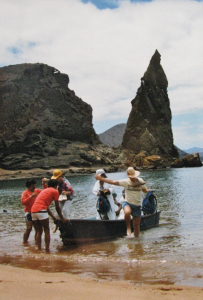
Oddly enough, I visited the Galapagos Islands the year Vonnegut first published his book. Every tourist to Galapagos takes a picture of this rock. Here’s mine.
which can’t be trusted, cause us a lot of trouble, and aren’t very smart after all. The real you is your “soul” which can tell when the “brain” leads it astray. Life is futile and absurd – a viewpoint also found in his early works. I’m too much of an optimist to embrace his philosophy.
Galapagos was originally copyrighted in 1985, apparently before current writing advice to “show” not “tell”
The story is told by a all-knowing narrator who speaks from a million years in the future about what happened to the world in the year he was killed – 1986 – and to humanity over the next million years.
The writing is as quirky as the premise
and, while I’ll avoid spoilers, Vonnegut doesn’t. He puts an asterisk next to the names of characters who will soon be killed, even telling in advance who will be shot, who will be eaten by a shark, and who will “literally lose my head.”

Sea lions greet a Galapagos tourist ship – humanity’s past and future for Vonnegut
The narrator wanders back and forth across the action in 1986 and drops many hints of where mankind will be by the end of the story. If you’re anxious to follow the plot you’ll find the book frustrating. It’s best if you enjoy Vonnegut’s rambles.
What others say
There’s an ebook edition from 2011 available on Amazon which averages 4 out of 5 stars with 267 reviews. About a third of the reviewers were disappointed, finding the characters helplessly stupid or (worse!) boring, or the premise absurd.
As Jeremiah Jobling says, “I’m not saying it wasn’t a good(ish) book, but I found it far from being his best.”
A Customer complains “he clearly hasn’t bothered to learn much about the Galapagos Archipelago’s natural and human history.”
But keep in mind – 70% of reviewers loved it. As CV Rick says, for his fans, Vonnegut is “a master satirist with a rambling tone who seems to be going in wrong directions, but ties all threads together brilliantly.”
Filed under: Science Fiction Tagged: end of world, Galapagos, Kurt Vonnegut, satire, SciFi








February 17, 2016
Billion Year Old Ghost #star #space #science #amwriting #poem
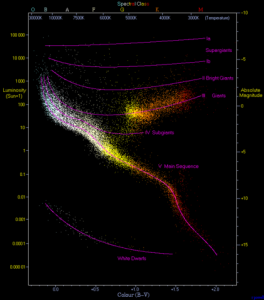
charting the stars
Fourteen billion years ago,
Photons first became.
Twelve billion years ago they left
The first star ending darkness’ reign.
A star three times older
Than our own life-giving Sun,
Its photons traveled all that time
Till in our scopes their trip was done.
Our Sun will last another
Four or five billion years,
And collapse to carbon ash
Long after we were here.
The first star has had the time
To go supernova.
We see its birth when we look up
Though death has taken over.
Who will watch our Sun expand
And boil away Earth’s seas?
Who will see its giant phase?
Its helium flash recede?
Whoever turns their optics on,
Across the universe,
May still admire our pleasant orb
When Earth’s life has dispersed.
By Kate Rauner
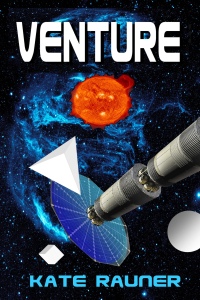 In my science fiction novel Venture, a space station encounters the evolution of a
In my science fiction novel Venture, a space station encounters the evolution of a
main sequence star, along with asteroid mining and crew conflicts. Journey with them.
Thanks to straightdope.com which reposted this article from April, 2000 – another message from the past.
The fate of our Sun is explained here: universetoday
Filed under: Kate's Books, Poetry, Science Fiction Tagged: deep time, fourteen billion years, main sequence star, photon, star, sun, supernova








February 13, 2016
I’m Number 421! Still a strange boast #amwriting #amreading #scifi #Mars colony
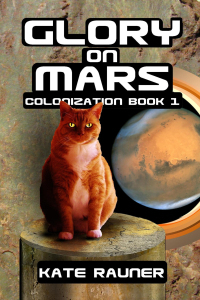 I’ve said this before – it may not make much of a bumper sticker, but my new book Glory on Mars is in the top fifth of its Amazon Kindle category. That’s a thrill for me – an unknown author. I’ve been told 90% of the books sold in America are written by 1% of the authors.
I’ve said this before – it may not make much of a bumper sticker, but my new book Glory on Mars is in the top fifth of its Amazon Kindle category. That’s a thrill for me – an unknown author. I’ve been told 90% of the books sold in America are written by 1% of the authors.
It’s so hard to break into writing. Thanks to everyone who read Glory on Mars. Hurry to enter for a free copy at LibraryThing.
I hope you’ll try Born on Mars, too.
Please consider posting a review – on Amazon, Goodreads, your favorite retailer, or wherever you hang out. That’s how books get noticed.
My books are available from all major retailers – more links here.
Now I’ve got to hurry and post this while it’s still true – things change quickly on Amazon.
Filed under: Kate's Books, Science Fiction Tagged: #marssurvivaltips, book, colonization, colony, ebook, mars, novel, science fiction, SciFi, settlers








Einstein Was Right #Einstein #GravitationalWaves #science #physics #EinsteinWasRight #GravityWaves
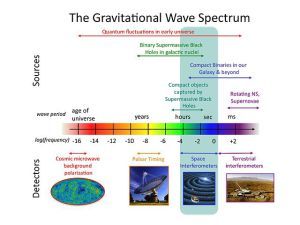 Over a billion years ago, two black holes that had been orbiting each other smashed together. Ripples in space-time from the collision reached Earth. Specifically, the waves reached a pair of giant interferometers in the United States, located in Louisiana and Washington state.
Over a billion years ago, two black holes that had been orbiting each other smashed together. Ripples in space-time from the collision reached Earth. Specifically, the waves reached a pair of giant interferometers in the United States, located in Louisiana and Washington state.
Scientists have for the first time detected gravitational waves, ripples in space and time hypothesized by Albert Einstein a century ago, in a landmark discovery announced on Thursday that opens a new window for studying the cosmos…
The colliding black holes that produced these gravitational waves created a violent storm in the fabric of space and time, a storm in which time speeded up, and slowed down, and speeded up again, a storm in which the shape of space was bent in this way and that way.
I’m no physicist, but I find it easier to picture gravity as a warping or reshaping of space and time, not a fog of quantum particles. Transmogrified to an audio signal, something a person can experience, black holes go whoop.
I’ve read that Einstein’s work has been overwhelmed by quantum mechanics. Even, if you view PhDs as the children of their advisors, that Einstein’s line has gone extinct. So in addition to wondering what new view we’ll have of the universe by looking at gravity waves, I feel good about this discovery.
This is probably not good news for anyone’s grand unified theory of everything. Gravity remains different from the other fundamental forces of electromagnetism, weak nuclear, and strong nuclear. Nature refuses to settle into a neat, tidy human understanding.
How frustrating, how problematic, how infuriating. How awesome.
Thanks to reuters for the quotations above. Many outlets covered the news.
Filed under: Neat Science News Tagged: Albert Einstein, black hole, fundamental force, gravitational wave, Gravity, Physics, Quantum mechanics








February 10, 2016
Daily Mathematics #math #science #poem #poetry

The logarithmic spiral of the Nautilus shell is a classical image used to depict the growth and change related to calculus
My grocery store is only
A twenty minute drive,
A statement based on distance,
Related speed and time.
You understand my drive at once,
It causes you no fuss.
Who says you don’t comprehend
Integral calculus.
By Kate Rauner
Filed under: Poetry Tagged: calculus, distance, math, mathematics, speed, time








February 6, 2016
Earth Can’t Hide Alien Boy Forever #fantasy #book #newadult #scifi
 I Am Number Four was written for teenage boys. Five years after publication, it still scores in the top couple percent of its Amazon sales categories. I like a lot of Young Adult books, so I had high expectations.
I Am Number Four was written for teenage boys. Five years after publication, it still scores in the top couple percent of its Amazon sales categories. I like a lot of Young Adult books, so I had high expectations.
You may recall the book was made into a movie in 2011. From comments I read, the movie was forgettable. But that’s not unusual for a movie adaptation, so I don’t hold it against the book.
I guess I’m just too-much-not a teenage boy. My reaction is a more modest “meh.”
Swords mean fantasy
Despite being tagged as science fiction, this is a fantasy story – not that there’s anything wrong with that. It may have aliens but – come on – it opens with swords. Magical swords.
The fifteen year old hero comes from a world where some kids – called Garde – are super-strong and super-fast. But that’s just the beginning. They develop specific superpowers in their teens, like becoming invisible or fire-proof. An alien race of monstrous beings has slaughtered the inhabitants of their home world. (Because the monsters destroyed the environment on their home planet – a little message there.)
Despite having killed a whole planet’s population of super-powered people, the monsters feel threatened by nine Garde who escaped to Earth as young kids. The monsters are therefore hunting them and their adult companions – each kid has one Cepan, or guardian. The Garde/Cepan pairs scatter and hide. Fortunately, they look exactly like humans and fit in perfectly. Of course, they don’t reveal their alien nature to anyone on Earth or ask for help.
There’s more magic
Because of a “charm” the monsters can only kill the kids in a certain sequence and if they kill one, a scar magically appears on the ankles of the others. Three scars have appeared on Number Four, so he knows he’s next. He and his Cepan move and assume new identities twice a year anyway, so when that third scar appears, they run – to a tiny rural town with a surprisingly well equipped high school – the home ec lab has ten kitchens and there’s a class in astronomy.
None of that is a spoiler because it’s all explained in the first few pages. Then the story can begin.
As the August 2010 “Amazon Best Books” review says
“I Am Number Four is a breathless page-turner of a sci-fi novel that will have readers rooting for the teen alien who must unleash his fire power to save himself, his human friends, and the planet.”
At fifteen, Number Four, going by the name John Smith, is due to develop his superpowers any day now. But his first concern is with the stereotypes at his new school – a pretty girl who makes him nervous when she’s nice to him (which leads to a lot of kissing), a bully jock, and a geek in a NASA tee-shirt. At least John gets to adopt a strange stray dog.
I was indeed turning pages quickly, scanning rather than reading every word after John’s first couple days in his new school. Some of the story I expected but there was also a quirky twist I liked. I don’t think it will be much of a spoiler to say there’s a climatic battle.
BTW – the author is shown as Pitticus Lore – a name from the Garde’s world. Cute.
Tremendously popular
With over 1,000 Amazon reviews averaging four stars, and still ranked number three in its kindle Best Sellers category of sci-fi aliens, you don’t need me to tell you this book is hugely popular. The follow-on books in the series are, if anything, more highly rated and close behind I Am Number Four in sales ranking. I’ll just add this book is most likely to appeal to tween and teen readers.
Filed under: Science Fiction Tagged: alien, battle, Fantasy, magic, monster, new adult, Pitticus Lore, science fiction, SciFi, sword, young adult








February 3, 2016
Geometry at Night #science #math #geometry #poem

Cuneiform tablets
A holy city worshiped bulls
Two thousand years ago
And gave the world astrology
Or so the story goes.
Masters of geometry
They watched the sky at night
Saw stars that moved in retrograde
And puzzled at the sight.
Movements of the planets
Produce a twisted dance
They charted it with dents in clay
They had no proper graphs.
Geometry was once supreme
Before the calculus
Trapezoids drawn in the sky
For brains that functioned thus.
by Kate Rauner
Geometry is different – I’ve noticed that some people connect with geometry even if other forms of math leave them cold.
Astroarchaeologist Mathieu Ossendrijver, of Humboldt University in Berlin, has deciphered cuneiform tablets that predicted the planet Jupiter with fancy geometry found nowhere else in the ancient world.
“Ancient Babylonians used a complex geometrical model that looks like a rudimentary form of integral calculus to calculate the path of Jupiter. Scientists previously thought this mathematical technique was invented in medieval Europe.” livescience.com
“Trapezoid calculations were a tool for calculating Jupiter’s displacement each day along the ecliptic, the path that the sun appears to trace through the stars. The computations recorded on the tablets covered a period of 60 days, beginning on a day when the giant planet first appeared in the night sky just before dawn… Learning how the Babylonians astronomers acquired their geometric acumen ‘would tell us something about why human beings do science in the first place, and from time to time do it very well indeed.'” sciencemag.org
Filed under: Poetry Tagged: anthropology, astroanthropology, Babylon, cuneiform, geometry, math, mathematics, science








January 30, 2016
Eat Like a Martian – Cassava #MarsSurvivalTips #scifi #Mars #book
Settlers on Mars will need to grow their own food. While potatoes may appeal 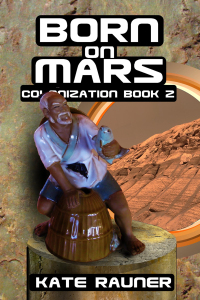 to Americans, the Sino-African colony that joins the first settlers in Born on Mars rely on cassava. As one of the most drought-tolerant crops that can grow in marginal soils, it seems like a good candidate for Mars.
to Americans, the Sino-African colony that joins the first settlers in Born on Mars rely on cassava. As one of the most drought-tolerant crops that can grow in marginal soils, it seems like a good candidate for Mars.
You may have heard of cassava as part of popular “paleo” diets.
Two types of cassava are a staple food for over half a billion people in the developing world. Bitter cassava (roots, peels, and leaves) has cyanide based compounds that must be removed via proper cooking, but sweet cassava contains very few such compounds and has a delicate flavor.
 One traditional preparation is to mix a thick paste of cassava flour and water, spread it in a thin layer spread over a basket, and let it stand in the shade for five hours so the cyanide compounds break down. Another is to peel the roots and soak them in water for three days to ferment. The roots then are dried or cooked.
One traditional preparation is to mix a thick paste of cassava flour and water, spread it in a thin layer spread over a basket, and let it stand in the shade for five hours so the cyanide compounds break down. Another is to peel the roots and soak them in water for three days to ferment. The roots then are dried or cooked.
But perhaps settlers on Mars can skip those steps. If I can give my scifi settlers a cool Artificial Intelligence and construction robots, surely I can give them cassava bred to remove cyanides.
Cassava Porridge
1) Bring 2 cups of water to a boil.
2) Meanwhile, beat cassava flour into 2 cups of cold water until the mixture is smooth.
3) Add the cassava mixture to the boiling water.
4) Keep stirring until the mixture is smooth.
5) Cover the porridge and place in a 350ºF oven.
6) Bake until the mixture has thickened to a dough-like consistency – about 45 minutes.
I think I’d like to sweeten it with stevia.
Noodles
Step One:
1) In a large bowl, mix 1 cup cassava flour with 3 to 4 tablespoons cooking oil and 1/2 teaspoon salt. On Earth, add a couple eggs and the noodles will hang together better.
2) Use your hands (don’t burn yourself!) to blend and knead the mixture into a ball of dough
3) Lightly dust an area to roll out your ball of dough with a bit of cassava flour
4) Roll out your dough with a rolling pin to desired thickness
5) With a straight edged knife, slice your noodles as fat or thin as you like.
Step Two:
1) Bring 8 cups of water to a boil
2) Transfer the noodles to the boiling water and cook until they float, just a few minutes
3) Remove noodles from the water with a slotted spoon and transfer them to a strainer
4) Shake off excess moisture and dust with finely chopped herbs
For more Eat Like a Martian:
fish supper
mealworm snack
practice for Mars on Earth
Banana beer from Born on Mars
And Liz, in Glory on Mars, tries to make bhang, though she doesn’t have all the ingredients.
Thanks to
portuguese recipes cassava porridge
Filed under: Kate's Books, Science Fiction Tagged: Cassava, food for colony settlers, mars, paleo diet, science fiction, SciFi








January 27, 2016
Age of Humanity #poetry #anthropogenic

How does a mine move so much dirt? Here’s my car next to a mine truck tire.
Our numbers and our industry,
Fossil-fuels and farming,
New minerals called pottery –
Are bricks and glass alarming?
Chemicals that we create,
Plastics, fibers, microbeads –
Mining moves three times more silt
Than all Earth’s rivers can succeed.
Greenhouse gases, mass extinction,
And synthetic fertilizer
Disrupts Earth’s nutrient flow,
Leaves Nature’s rate of change a miser.
Only since the last Ice Age
Came a Totally New Epoch.
We have grown civilized
And now see where that led us.
Epochs used to last for ages,
Now the Holocene,
Only twelve millennia old,
Yields to – Anthropocene.
We humans mark the planet,
We humans modify,
We humans are the greatest cause,
We’re fruitful and we multiply.
Thanks to bloomberg.com for five signs of the Anthropocene. I’ve posted about the Epoch of Humanity before. It started in the year 1610 CE.
Filed under: Poetry Tagged: Anthropocene, epoch, fertilizer, Holocene, human impact, Ice Age, mass extinction











